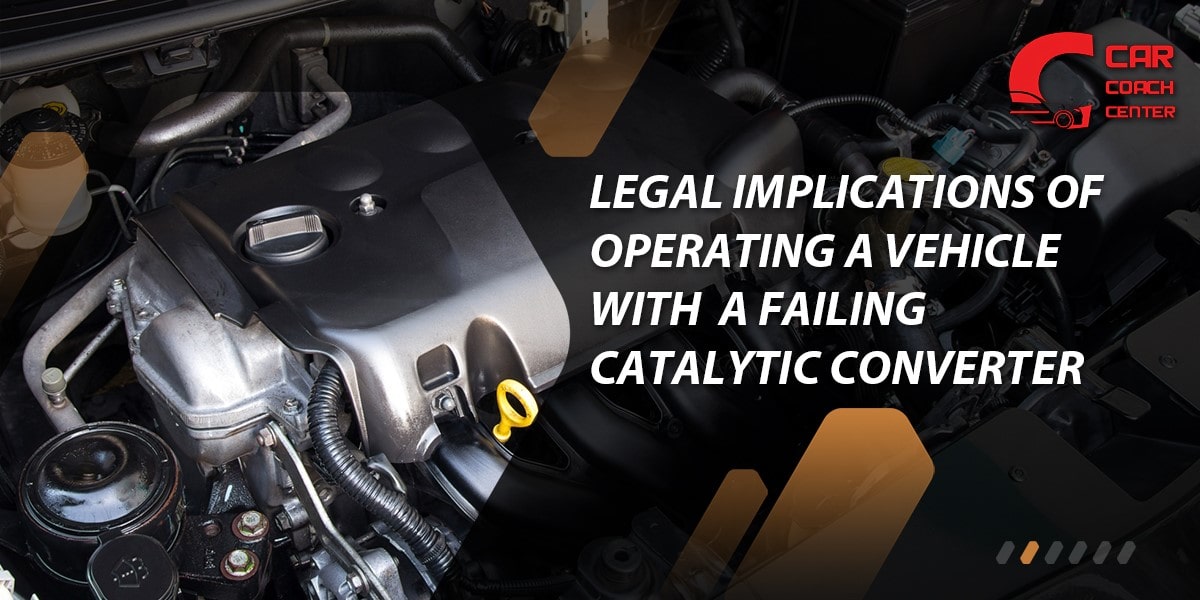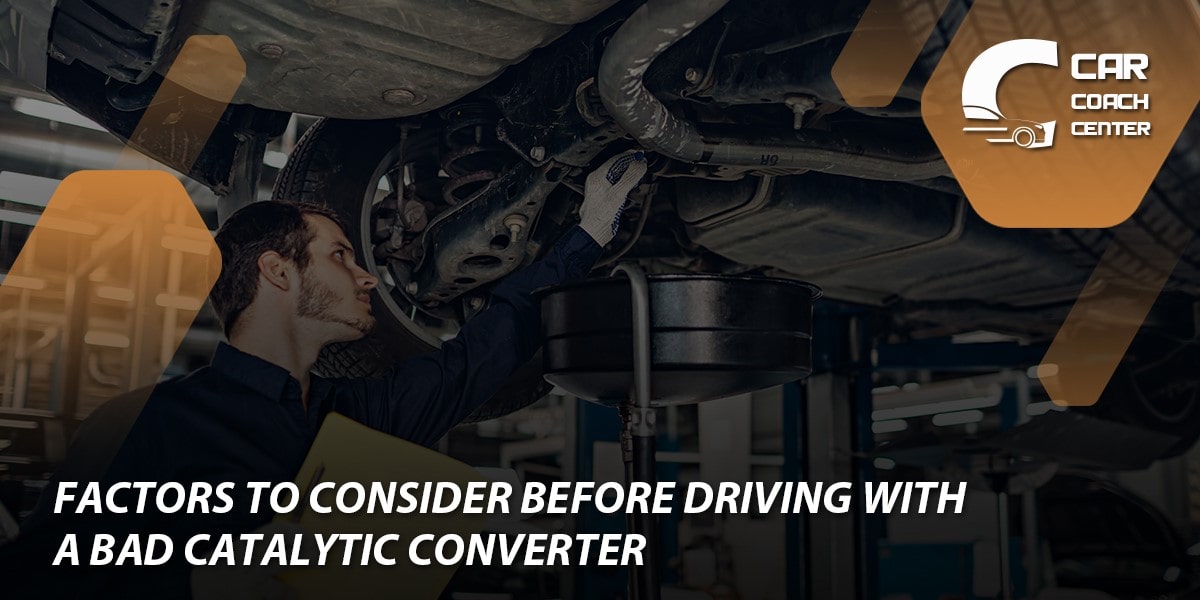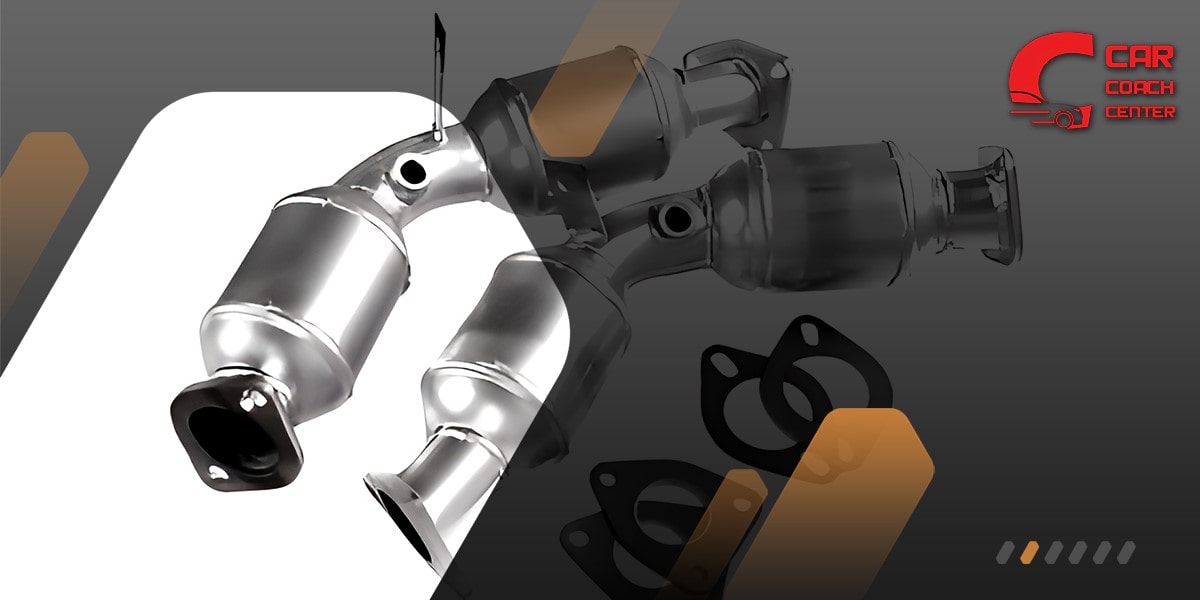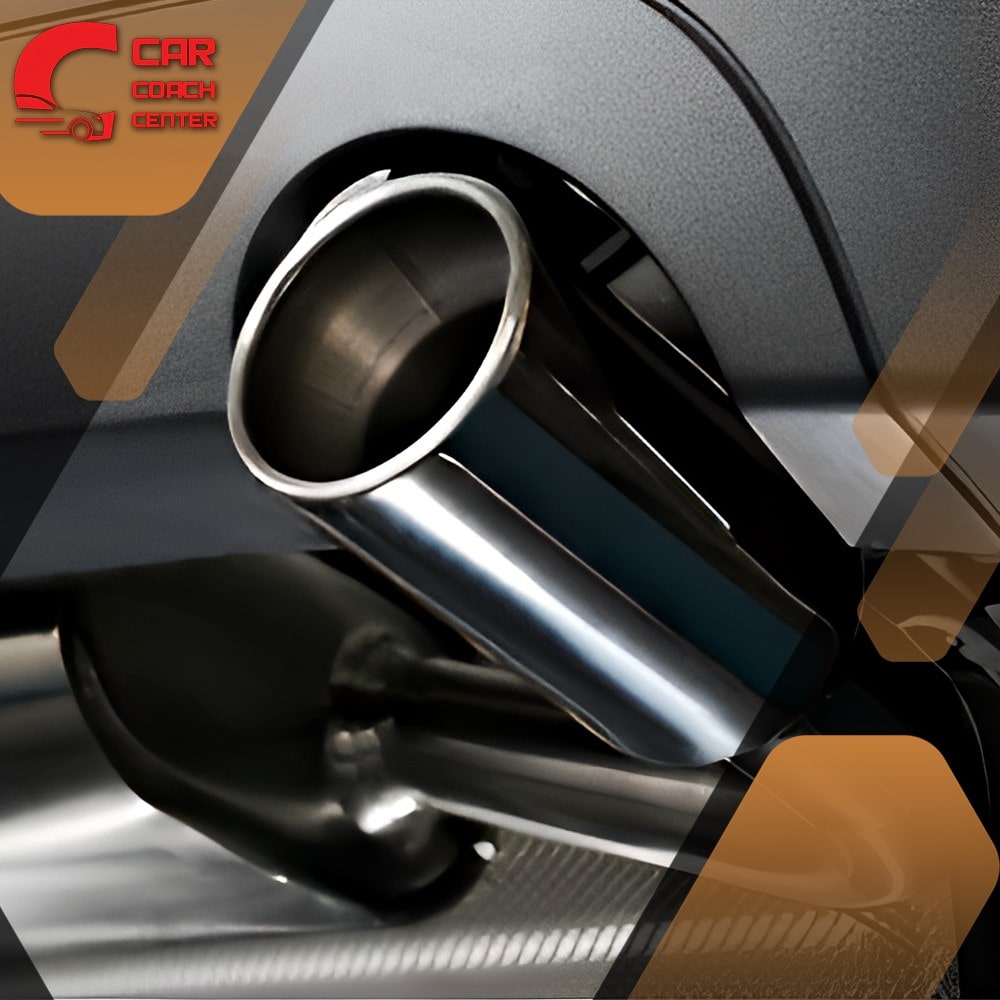Can I Drive With A Bad Catalytic Converter
The catalytic converter, a vital component of your vehicle’s exhaust system, is crucial in reducing harmful emissions and maintaining a cleaner environment. However, like any automotive part, catalytic converters can deteriorate over time and develop issues that compromise effectiveness. This leads to an important question for car owners: Can you continue driving with a bad catalytic converter?
This article will delve into this topic to comprehensively understand the implications and considerations associated with a failing catalytic converter. We will explore the signs of a deteriorating catalytic converter, the potential risks of driving with one, legal implications, temporary solutions, professional repair options, and maintenance tips to help you make informed decisions about your vehicle’s health and the environment. So, if you’re wondering whether it’s safe to drive with a bad catalytic converter, read on to discover the answers and guidance you need.

Understanding the Role of a Catalytic Converter
The catalytic converter is a crucial component of your vehicle’s exhaust system, which is vital in reducing harmful emissions. It is designed to convert harmful gases produced during combustion into less harmful substances before they are released into the environment.
The primary function of a catalytic converter is to reduce three major pollutants: nitrogen oxides (NOx), carbon monoxide (CO), and hydrocarbons (HC). These pollutants are byproducts of fuel combustion in the engine and can harm human health and the environment.
The catalytic converter achieves its purpose through a series of chemical reactions inside its core. The core of the catalytic converter is made up of a honeycomb-like structure coated with catalysts, typically consisting of platinum, palladium, and rhodium.
Common Signs of a Failing Catalytic Converter
Detecting a failing catalytic converter early is crucial to prevent further damage to your vehicle and ensure compliance with emission regulations. Here are some common signs that indicate a potential issue with your catalytic converter.
Check Engine Light
One of the first indicators of a failing catalytic converter is the illumination of the check engine light on your vehicle’s dashboard. The onboard diagnostics system monitors the performance of various components, including the catalytic converter. It will trigger the check engine light if it detects an issue with the converter’s efficiency or emissions.
Decreased Engine Performance
A failing catalytic converter can negatively impact your vehicle’s engine performance. You may notice decreased power, sluggish acceleration, or difficulty maintaining speed. This can occur because the catalytic converter becomes clogged or restricted, affecting the exhaust flow and causing a reduction in overall engine efficiency.
Increased Exhaust Emissions
A failing catalytic converter may lead to an increase in harmful emissions coming from your vehicle’s exhaust. If you notice excessive smoke, a strong rotten egg odor (sulfur smell), or a black sooty residue on the tailpipe, it could be a sign that the catalytic converter is not effectively converting pollutants into less harmful substances.

Failed Emissions Test
During emissions testing, a faulty catalytic converter may cause your vehicle to fail the test due to increased emissions. If your vehicle consistently fails emissions tests despite proper maintenance and tune-ups, it’s worth investigating the condition of the catalytic converter.
Rattling or Noisy Exhaust
A deteriorating catalytic converter may develop internal damage or lose its structural integrity, resulting in a rattling noise from the exhaust system. This noise is often more noticeable when the vehicle is idling or during acceleration. It is an indication that the catalytic converter may be breaking apart internally.
Reduced Fuel Efficiency
A failing catalytic converter can contribute to decreased fuel efficiency. If you find yourself refueling more frequently than usual, despite normal driving habits, it could result from an inefficient catalytic converter. The increased backpressure caused by a failing converter can lead to poor combustion and higher fuel consumption.
The Potential Risks of Driving with a Faulty Catalytic Converter
While it may be tempting to ignore a failing catalytic converter and continue driving, doing so can pose several risks to both your vehicle and the environment. Here are some potential consequences of driving with a faulty catalytic converter.
Reduced Engine Performance
A failing catalytic converter can lead to a decrease in engine performance. As the converter becomes clogged or restricted, it obstructs the flow of exhaust gases, causing backpressure in the exhaust system. This increased backpressure can result in reduced engine efficiency, leading to a loss of power, decreased acceleration, and poor fuel economy.
Engine Damage
If a catalytic converter becomes severely clogged or damaged, it can negatively impact other engine components. The increased backpressure can cause excessive heat buildup, which may damage the engine valves, pistons, or even the cylinder head. Over time, this can result in costly repairs and potential engine failure.
Further Damage to the Exhaust System
A failing catalytic converter can also cause damage to other parts of the exhaust system. The increased backpressure can strain the exhaust manifold, oxygen sensors, and muffler, potentially leading to premature failure. Replacing these components, in addition to the catalytic converter, can significantly increase repair costs.
Increased Environmental Impact
One of the primary functions of a catalytic converter is to reduce harmful emissions before they are released into the environment. A faulty catalytic converter is less effective in converting pollutants, leading to increased emission levels of nitrogen oxides (NOx), carbon monoxide (CO), and hydrocarbons (HC). This contributes to air pollution, compromising air quality and exacerbating environmental concerns such as smog and global warming.
Legal Consequences
Driving with a faulty catalytic converter may also have legal implications. Many jurisdictions have strict emission regulations, and vehicles must meet certain emission standards. Operating a vehicle with a malfunctioning catalytic converter may lead to penalties, fines, or even vehicle registration suspension if it fails emission tests or violates regulatory requirements.

Legal Implications of Operating a Vehicle with a Failing Catalytic Converter
Operating a vehicle with a failing catalytic converter can have significant legal implications. Understanding the regulatory requirements regarding catalytic converters and the potential consequences of non-compliance is essential. Here are some key aspects to consider.
Emission Regulations
Most countries and regions have established emission regulations that vehicles must adhere to. These regulations set limits on the amount of pollutants that vehicles can emit, including nitrogen oxides (NOx), carbon monoxide (CO), and hydrocarbons (HC). Catalytic converters are crucial in reducing these emissions to meet the established standards.
OBD-II System and Emissions Testing
Modern vehicles have an Onboard Diagnostics II (OBD-II) system that monitors various components, including the catalytic converter, to ensure proper functionality and emissions control. If the OBD-II system detects a fault with the catalytic converter, it will trigger the check engine light and store an error code. During emissions testing, these error codes or a failing catalytic converter can cause a vehicle to fail the test.
Penalties and Fines
Driving with a faulty catalytic converter that causes a vehicle to exceed the permitted emission limits can result in penalties and fines imposed by regulatory authorities. The specific penalties vary depending on the jurisdiction, including monetary fines, vehicle impoundment, or vehicle registration suspension. Repeated offenses or intentional emission control system tampering can lead to more severe penalties.
Vehicle Registration and Inspections
In some regions, regular vehicle inspections are required to ensure compliance with emission standards. During these inspections, the functionality of the catalytic converter may be checked. Suppose the catalytic converter is defective or not meeting the required standards. In that case, it may prevent the vehicle from passing the inspection, resulting in the inability to renew or obtain vehicle registration.
Environmental Impact
Besides legal implications, driving with a failing catalytic converter has environmental consequences. The increased emissions can contribute to air pollution, degrade air quality, and harm human health. It also undermines efforts to combat climate change and preserve the environment. Complying with emission regulations by maintaining a functional catalytic converter is essential to reducing environmental impact.

Factors to Consider Before Driving with a Bad Catalytic Converter
When faced with a failing catalytic converter, it’s essential to carefully evaluate several factors before deciding whether to continue driving with the issue. While immediate repair or replacement is generally recommended, certain circumstances require thoughtful consideration. Here are some factors to consider before driving with a bad catalytic converter.
Severity of the Issue
Assess the severity of the catalytic converter problem. Is it a minor issue that affects performance but doesn’t significantly impact emissions, or is it a major malfunction that causes excessive emissions and potential damage to the engine? Understanding the extent of the problem will help determine the associated risks and whether temporary solutions or immediate repair is necessary.
Safety Concerns
Consider the impact of a failing catalytic converter on vehicle safety. If the converter is severely clogged or damaged, it can lead to decreased engine performance, increased exhaust temperature, or even engine failure. These factors can compromise safety, especially in critical situations such as long trips or driving in extreme weather conditions. Safety should be a top priority when deciding whether to continue driving with a faulty converter.
Environmental Impact
Evaluate the environmental consequences of driving with a bad catalytic converter. A failing converter contributes to increased emissions of harmful pollutants, compromising air quality and the environment. If reducing your carbon footprint and minimizing pollution is important, it is advisable to address the issue promptly to maintain a cleaner and healthier environment.
Legal Requirements
Research and understand the emission regulations and legal requirements in your jurisdiction. Driving with a faulty catalytic converter may result in penalties, fines, or even vehicle registration suspension if it violates emission standards. Compliance with legal obligations is crucial, and non-compliance can lead to significant consequences.
Financial Considerations
Consider the financial aspects associated with repairing or replacing the catalytic converter. Evaluate the cost of the necessary repairs or the purchase of a new converter, considering your budget and the potential long-term savings in fuel efficiency and reduced future repair expenses. Balancing the immediate financial impact with the potential benefits of repair or replacement will help you make an informed decision.
Long-Term Implications
Think about the long-term implications of driving with a faulty catalytic converter. Ignoring the issue can lead to further damage to the engine or other exhaust system components, resulting in more extensive repairs and higher costs down the line. In the long run, assessing the potential consequences can guide your decision-making process.

Temporary Solutions and Workarounds for Driving with a Bad Catalytic Converter
While driving with a failing catalytic converter is generally not recommended due to the potential risks and environmental impact, drivers may consider some temporary solutions and workarounds under specific circumstances. These temporary measures can help alleviate some of the symptoms of a bad catalytic converter but should not be viewed as permanent fixes. Here are some options to consider.
Check and Replace Air Filters
A clogged or dirty air filter can contribute to a malfunctioning catalytic converter. By inspecting and replacing the air filter if necessary, you can ensure that the engine receives the proper air-to-fuel ratio, improving overall combustion efficiency. This may temporarily alleviate some issues associated with a bad catalytic converter.
Use Fuel Additives
Fuel additives designed to clean the catalytic converter and remove carbon deposits may provide a short-term improvement in its performance. These additives can help unclog or reduce minor obstructions in the converter, improving exhaust flow and reducing emissions temporarily. However, they are not a long-term solution and may not be effective for severe issues.
Avoid Aggressive Driving
Aggressive driving habits, such as rapid acceleration and hard braking, can increase stress on the catalytic converter and exacerbate existing issues. Adopting a more gentle driving style can reduce the strain on the converter and prolong its limited functionality. Smooth driving can also help improve fuel efficiency.
Clear Error Codes (Check Engine Light)
If the check engine light is illuminated due to a catalytic converter-related issue, you can temporarily clear the error codes to turn off the warning light. This action, however, will not fix the underlying problem and may lead to further complications. The check engine light is an essential indicator of potential issues in your vehicle, and it is crucial to address the root cause rather than ignore it.
Consult a Professional Mechanic
If you are considering driving with a failing catalytic converter, seeking advice from a qualified mechanic or automotive technician is essential. They can thoroughly inspect the converter and determine the extent of the problem. A professional assessment can help you better understand the risks and whether any temporary measures suit your situation.
It is crucial to emphasize that these temporary solutions are not substitutes for proper repairs or replacement of a faulty catalytic converter. Continuing to drive with a malfunctioning converter can lead to further damage to the vehicle, increased emissions, and potential legal consequences. Temporary solutions should be limited to exceptional circumstances and as a short-term measure while arranging for the necessary repairs or replacements.
The next section will explore the professional repair options available to effectively address a failing catalytic converter and restore your vehicle’s performance and environmental compliance.
Conclusion
In conclusion, the catalytic converter plays a vital role in reducing harmful emissions and maintaining the overall performance of your vehicle. Driving with a bad catalytic converter can lead to risks, including compromised safety, environmental damage, and potential legal implications. While temporary solutions may provide short-term relief, seeking professional assistance and addressing the issue promptly is crucial for long-term vehicle health.
At CarCouchCenter.com, we understand the importance of maintaining a healthy catalytic converter and promoting responsible driving practices. We have explored the role of the catalytic converter, common signs of failure, potential risks, legal implications, factors to consider before driving with a faulty converter, temporary solutions, and the significance of seeking professional assistance.
Furthermore, we have highlighted the importance of preventive maintenance to keep your catalytic converter in optimal condition and prevent future issues. Learn about temporary solutions, seeking professional assistance, and preventive maintenance to ensure a healthy catalytic converter. Visit CarCouchCenter.com for expert advice on automotive care and responsible driving.
Can I drive with a bad catalytic converter temporarily?
While driving temporarily with a bad catalytic converter is possible, it's not recommended due to potential risks and environmental impact.
Will driving with a faulty catalytic converter damage my engine?
A failing catalytic converter can cause engine damage if left unresolved, potentially leading to more extensive repairs.
Are there any legal consequences for driving with a bad catalytic converter?
Driving with a faulty catalytic converter can result in legal implications, including fines and potential suspension of vehicle registration.


